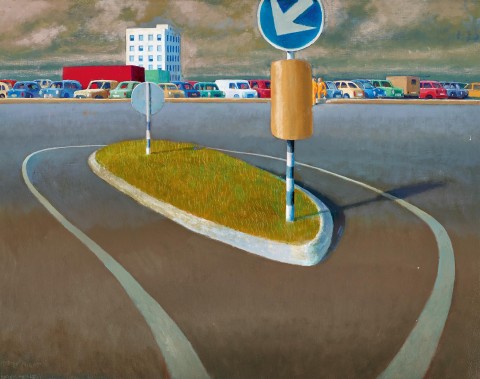THE TRAFFIC ISLAND, 2009
JEFFREY SMART
oil on canvas
82.0 x 104.5 cm
signed twice lower left: JEFFREY SMART
Australian Galleries, Melbourne (label attached verso, stock no. AG105625)
Private collection, Melbourne
Jeffrey Smart, Paintings and Studies 2006 – 2010 and one drawing from 1946, Australian Galleries, Melbourne, 22 June – 10 July 2010, cat. 17
Heathcote, C., ‘The Smart Touch’, Art Monthly, Canberra, No. 231, July 2010, p. 35
We are grateful to Stephen Rogers, Archivist for the Estate of Jeffrey Smart, for his assistance with this catalogue entry.
Jeffrey Smart followed throughout his career a template of formal geometric composition (almost abstract in its rigour) inhabited by figures acting out an unknowable narrative. In a manner that would have made Baudelaire proud, Smart translated the beauty he found in the impassive observation of his present-day surroundings, placing formal order first and foremost in his practice. Although he spent the last forty years of his life living and working in Tuscany, Smart continued to paint from there the globally uniform imagery of post-war urban boom, particularly the arterial roads which had smoothed out the path to economic progress. It was the sculptural and semiotic qualities of these concrete and steel monuments that Smart admired and conveyed in his works.
Not quite as hard-edged as some of Smart’s other roadside paintings, The Traffic Island, 2008 is dominated by the sinuous contours of the street furniture itself, further reinforced by its white delimitating lines painted directly on the bitumen. With subject matter and composition reprised from an earlier painting from his extensive back-catalogue, The Island, 1962 (Royal Perth Hospital Collection), here the eponymous traffic island floats in the foreground. While its point juts out towards the viewer, the road rises up behind it, meeting a narrow band of sky on a horizon interrupted by a single multi-storey apartment block and a belt of parked candy-coloured cars and lorries.
For all of Smart’s meticulous realism, his paintings are in fact carefully constructed. Based on real-life locations, his views are then simplified and re-arranged into geometrically logical compositions, whittled into concise images through a process of multiple preparatory studies in both pencil and oil. Through this process, Smart sought out the stillness he felt came from a well-designed picture.1 In this, Smart is an inheritor of the masters of the Italian High Renaissance, whom he greatly admired.
With a painterly texture characteristic of his later works (a product of a more coarsely woven canvas), Smart creates a stark contrast between the creeping shadows of the foreground and the raking afternoon light hitting the street signs and bright white façade of the apartment block. This confers a rare and unusual beauty on an otherwise banal section of urban planning. By tightly cropping his composition, enough to clip the top of the road sign, Smart creates an impression of a scene isolated with a man-made viewfinder. The eye is drawn throughout the composition in a circular motion, directed by the blue and white arrow, converging on the reversed lollipop sign to the left of the composition.
Dwarfed in scale and almost hidden, Smart has painted two of his classic anonymous workers in overalls, perhaps responsible for the construction and maintenance of his imagined world? They idly chat beside the row of parked cars, resting against the kerbside in an otherwise deserted parking lot. While the parking lot is full, the motorists of these cars exist only outside of the frame. One can only guess at Smart’s suggested narrative.
Although it is tempting to read Smart’s works as critiques of urban alienation, as an evocation of Hopper-esque modern solitude, this wouldn’t give due credit to the wry humour encased within his compositions. Roads, in life like in Smart’s paintings, are carefully engineered and clearly delineated, herding the hidden hordes of citizens throughout space. Smart’s Italian autostrade are not formed by the intuitive and repetitive motions of desire paths; they efficiently direct the lonely viewer (motorist?) through the composition with precise instructions. A contradiction lies in this implied movement of the viewer and the hushed stillness of the freshly empty scene before them. The arrow indicates a direction in which the motorist/viewer should keep moving, circumnavigating this traffic island with no clear exit in sight. On the horizon, a hedge of tightly packed parked cars taunts with the promise of respite in the form of an unattainable parking spot.
1. Artist quoted in Smart’s Labyrinth, ABC TV, 10 May 1995
LUCIE REEVES-SMITH
